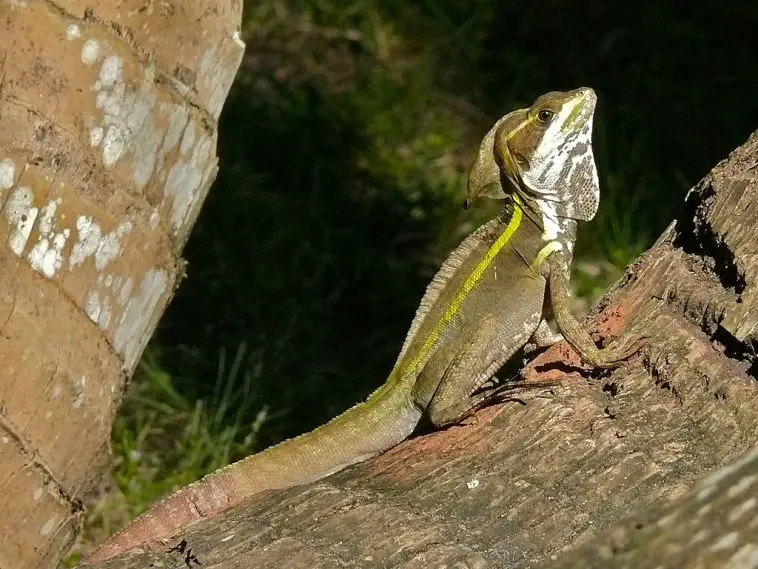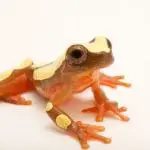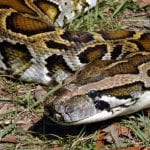Scientific Facts
| Common Name | Brown Basilisk (Striped Or Common) |
| Scientific Name | Basiliscus vittatus |
| Captive Lifespan | 8 – 12 Years |
| Size | 24 inches (60cm) |
| Mass | 0.44–1.32 lb. (200 – 600grams) |
| Habitat | Vegetation along with water bodies with sufficient sun exposure |
| Country of Origin | Central America |
Physical Description
Brown basilisks are thin, long, elegant lizards. The body coloration ranges in shades of beige and brown. Vividly-colored stripes of orange or yellow go from the head and all along to the very top of the abdominal zone.
Male brown basilisks are distinguished by the large plumes located on the tail, back, and head. As with many other reptile species, males are larger than females.
Types
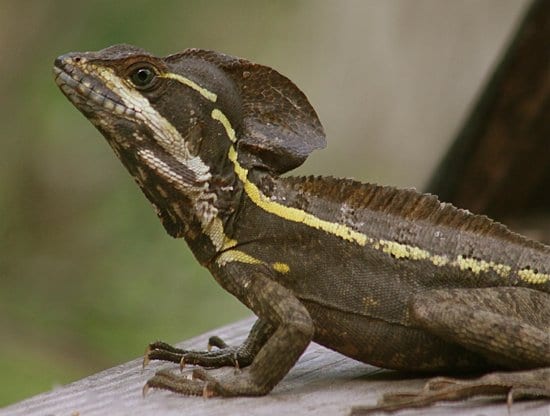
There are four species of lizards in the Basiliscus genus, namely the plumed or green basilisk (Basiliscus plumifrons), the stripped or brown basilisk (Basiliscus vittatus), the red-headed basilisk (Basiliscus galeritus), and thecommon basilisk, Basiliscus basiliscus.
The body coloration of these remarkable lizards ranges in various shades of green, yellow, black, brown, blue, and green.
Out of the four species, the striped basilisk is the smallest one. Males usually reach 18 – 22 inches, while males typically grow to 16 – 20 inches.
Green basilisks are considered the most strikingly colored ones. Although striped basilisks lack the bright green body coloration typical for the Basiliscus plumifrons, they do possess a large, distinct crest located on the very back of the head.
Habitat & Lifespan
Ranging throughout the northwestern coast of Ecuador, tropical Mexico and Jalisco, the genus Basiliscus is known to occupy South and Central America.
Dwelling along water basins, like riverbanks, where access to sufficient sunlight is offered, these lizards’ natural habitat in the wild also includes various vegetation, such as reed and overgrown trees.
Behavior

Wild basilisk lizards are rather erratic creatures. Their behavior is hard to predict, as they tend to keep changing from one activity to another all of a sudden.
These flighty reptiles often engage in climbing, as well as head bobbing, swiftly moving their heads up and down, as if showing respect or disapproval towards the contemplator. Basilisks spend most of their time high up in the trees or on the ground near water bodies.
Brown (common or stripped) basilisks also have the reputation of fairly good swimmers. When threatened, these lizards would often hide underwater, although this is only a last resort type of self-protective behavior. In most cases of being threatened, these lizards rear up, by using their tails for supreme stability and balance, allowing them to run extremely fast.
Probably the most intriguing behavioral trait of Basiliscus vittatus, apart from the ability to dive into the water and remain underwater if needed for the purpose of avoiding predators, is the almost supernatural ability to run over water for short periods of time. This is possible thanks to the hydrophobic scales locatedon the underside of brown basilisks’ feet.
Housing
- Overall, the enclosure should measure 4x2x3ft. For larger basilisks, an enclosure that measures 3 feet square x 5 feet tall is needed. However, the larger the enclosure, the better, so if possible, do not hesitate to make use of a bigger-sized terrarium.
- The enclosure should be constructed/selected in such a way as to be equipped with large vents needed for proper airflow, as well as with sliding front doors.
- In general, brown basilisks come from a naturally warm environment, so caregivers who happen to live in regions where the climate is cooler than the average should best consider opting for a wooden vivarium.
- For housing juvenile basilisks, there is no need to opt for a smaller enclosure, even though juveniles do not require much open space. Your best bet is to provide plenty of decorations, instead of using a smaller enclosure, and to slowly remove part of the decorations as the lizard continues to grow.
- In places where the climate conditions are appropriate, outdoor enclosures are highly recommended. The lizards can be brought indoors during the winter months.
- For outdoor enclosures, make sure to cover with plastic sheeting during the night if temperatures are to drop below the optimal rates.
- To help maintain temperatures stable, outdoor enclosures should be partially sunk into the ground at about 2 – 3 feet. In-the-ground concrete or block walls will act much like a buffer, aiding in stabilizing temperatures.
- Provide a forest-style terrarium with plenty of climbing possibilities. When using branches for this purpose, do not forget to ensure that these are clean of any possible toxic chemicals and/or parasites.
Substrate
- For indoor enclosures, mulch, sphagnum moss, soil, or a combination of these, can work great, especially for caregivers who wish to achieve a more naturalistic effect. Coarse bark chip is also an excellent bedding choice, being affordable, easy to maintain, and practically dust-free.
- For outdoor enclosures, normal soil is an excellent choice, as long as it has not been treated with any chemicals.
- Apart from the suitable, moisture-absorbing substrate, brown basilisks require absorbent decorations, as these creatures naturally thrive in humidity levels ranging from medium to high. By selecting the right type of substrate and decorations, keepers will ensure that moisture from the morning misting will be successfully absorbed and gradually released throughout the day.
- For bio-active enclosures, keepers want to opt for an organic soil mix, as well as to ensure that there is a drainage layer right below the soil.
Temperature, Lighting & Humidity
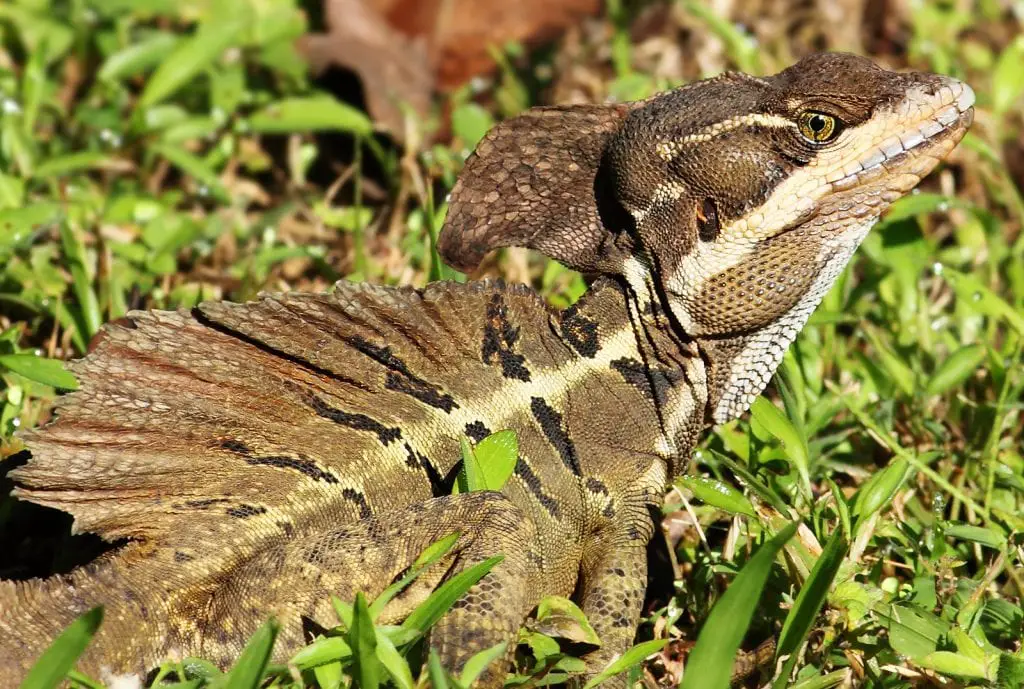
In the wild, brown basilisks are known to adapt to a fairly wide variety of habitats.
However, they are most commonly found to occupy drier zones located at up to 4950ft. elevation, where temperatures measure between 62 – 83 degrees Fahrenheit in the winter season to 73 – 92 degrees Fahrenheit in the summer season. Wild basilisks are also subjected to high humidity during the rainy season when about 4 to 7 inches of rain is produced monthly.
Keeping in mind the natural environmental conditions where these lizards thrive, it is the keeper’s responsibility to ensure the enclosure will provide adequate temperature, lighting, and humidity so that captive basilisks can live up to their fullest potential.
- For young basilisks, keep temperatures above 60 degrees Fahrenheit. If accidentally and only shortly exposed to temperatures below 45 degrees Fahrenheit, this should not cause lethal harm.
- During the day, maintain temperatures within the 75 – 95 degrees Fahrenheit range. During the night, you can allow temperatures to drop down to 61 – 74 degrees Fahrenheit.
- Brown basilisks’ enclosure must provide adequate ventilation, and a temperature gradient, too. Because of this, proper ventilation serves a dual purpose. First, it helps to remove heat from the cooler side of the enclosure, and secondly, it helps to keep temperatures on the warm side consistently warm.
- Brown basilisks are known for spending quite some time basking. In the wild, these lizards will receive a fairly good, natural shade cover, thanks to sitting on plants and treetops, however, they will still spend a decent amount of their time basking under the generously warm rays of the sun, getting the much-needed heat.
- In the basking area, temperatures should be maintained within the 90 – 95 degrees Fahrenheit range throughout the day.
- The basking area should make up for approximately 1/3 of the enclosure. The opposite side of the enclosure’s basking area should be tailored into a cooler zone.
- For creating a basking area, attach a basking lamp on one side of the enclosure’s ceiling. Make sure to use strong fixtures. Use a dimming thermostat to keep the temperatures stable throughout the day.
- Leave the basking lamp ON for 10 and up to 12 hours per day.
- For providing a clear day-and-night light cycle, it is a must to switch off all lights during the night, keeping the enclosure thoroughly dark.
- At night, temperatures will normally drop down, especially with the basking lights being switched off. However, it is best to keep night temperatures within the 80 degrees Fahrenheit range on the warmer side of the terrarium. For this purpose, you can utilize a ceramic lamp, attached to the back corner of the enclosure’s ceiling.
- If keepers are to utilize a ceramic lamp, it should be best surrounded by a cover/guard. Also, using a pulse thermostat is the most convenient and efficient way to maintain night temperatures within the desired rates.
- Ideally, by utilizing an appropriately-positioned ceramic bulb, you can maintain night temperatures within the 80 degrees Fahrenheit range in about 1/3 of the terrarium (the warmer side), while the temperatures in the rest of the enclosure will be able to drop down to room temperature.
- Throughout the day, ceramic lamps must be switched off.
- Although high-quality thermostats are reliable tools for temperature control, it is best to additionally make use of a thermometer for accurate monitoring. If the temperature on the basking site comes with 5 degrees Fahrenheit variance, this is nothing to be particularly worried about. However, dial thermometers installed on each side of the terrarium will greatly help to stay away from any unwanted issues related to unstable temperatures.
- Keepers are highly encouraged to opt for digital probe thermometers in favor of simple dial thermometers for improved accuracy.
- Regardless of the partial UVB sunlight cover brown basilisks get in the nature thanks to jungle plants and the canopy, captive brown basilisks do require an additional source of UVB light. This source should be semi-intense.
- For providing UVB light, keepers are recommended to opt for a 6% UV tube. The tube should run at a minimum of 2/3 of the enclosure.
- For a basic 4x2x4ft. enclosure, a UV tube of 6% strength is to be sufficient enough. However, for taller enclosures, you may need to opt for a tube of higher strength accordingly.
- You can find UV tubes in two sizes, namely T5 and T8. T5 lamps have an effective light range of 18 and up to 25 inches and are about ½ inch in diameter. These lamps last for 12 months on average and should be replaced accordingly.
- T8 lamps provide an effective range of 9 and up to 12 inches, and they measure about 1 inch in diameter. These lamps should be replaced every 6 months.
- For taller enclosures, a T5 unit is recommended. It should be attached to the ceiling, near to the back wall of the enclosure. By doing so, keepers will be able to provide a well-working UV gradient that will run all the way from the back of the enclosure to the front, and from top to bottom, also ensuring that the temperature gradient will be equally well-running along the width and the length of the terrarium. As a result, the basilisk will be free to find its ideal position inside at any time.
- Despite the fact that brown basilisks are basking-loving creatures, they do need an area where light is fully absent. This is easily achievable by providing full, as well as partial hiding spots.
- Full cover hiding spots include flat cork pieces, caves, as well as any other decorations that can provide a fully shaded spot for the lizard to rest. Partial hiding spots include various themed ornaments, trailing, and/or tall plants.
- The temperature gradient within the enclosure will allow these lizards to find the sweetest spot throughout the day and night. However, even when a basking site is provided, these reptiles will sometimes want to get really, very hot, and for this purpose, hardwood decorations are highly recommended.
- Suitable wood decorations include liana pieces and grapevines. These should be positioned close to the warm end within the enclosure, yet enough far away from the basking lamp, as not to allow the lizard to get in dangerously close contact with the lamp.
- Use tronchos branches, absorbent oak, or a network positioned right against the liana pieces/grapevines, in order to let the lizard easily get around its captive home.
- Other objects that can radiate the heat from the basking lamp for the purpose of providing a secondary belly heat within the enclosure will be highly appreciated by your captive brown basilisk. Heavy artificial ornaments can work great, and so will natural rocks, such as slate.
- When placing heat-radiating objects within the enclosure, always check whether the surface of these objects isn’t getting hotter than needed, as this can burn the animal. Position this type of decorations around and/or under the basking area.
- As far as maintaining proper humidity for captive brown basilisks is concerned, weekly misting of the enclosure is recommended.
Diet
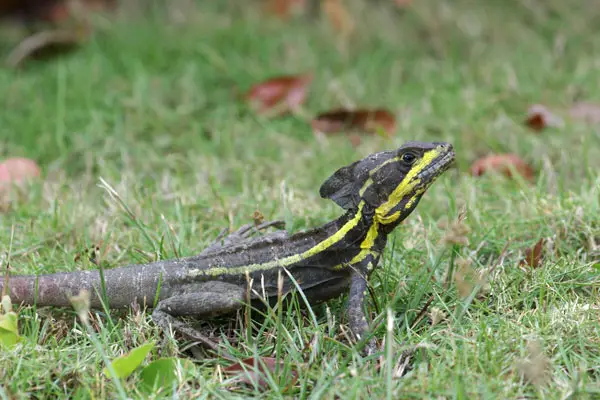
Brown basilisk lizards are omnivorous. This means that their diet consists of both meat and vegetation. However, in the wild, basilisks will rarely seek out vegetation to satisfy their appetites. This species is known to be far more oriented towards the meat present in its diet.
Wild brown basilisks thrive on catching a variety of small fish, invertebrates, as well as small mammals.
For captive basilisks, feeding live insects work best.
Eating Habits
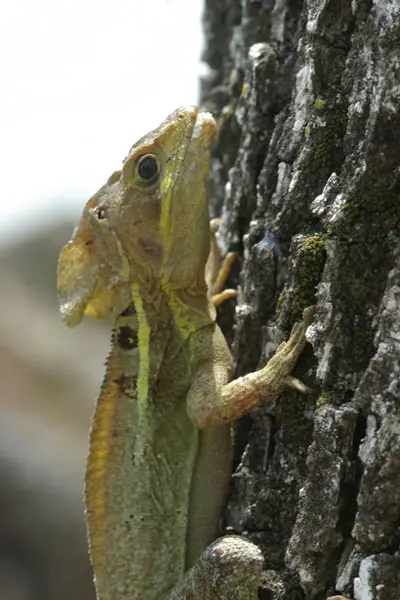
To satisfy the eating habits of your captive brown basilisk, feeding brown crickets is highly recommendable. Brown crickets are widely available and affordable, offering a great value for the money spent, as they are very rich in nutrients. Plus, brown crickets are quite easy and enjoyable for the basilisks to hunt down.
Sometimes, basilisks may refuse to take brown crickets, though, but this is not a reason to worry. If your basilisk doesn’t accept brown crickets, switch to feeding the lizard with locust and/or black crickets.
For providing a sweet treat to your basilisk pet every now and then, you can offer calciworms, beetle grubs, cockroaches, mealworms, and waxworms.
Mind that both worms and grubs are quite high in fats, so you only want to offer these as an occasional treat no more than twice, but better yet only once per week.
As to mealworms, cockroaches, and morio worms, it is important to know that these are difficult for your lizard to digest probably. Because of this, such treats should be only provided to basilisks over 18 months, only once and up to twice a week.
As to vegetation, you can offer your captive basilisk ripe berries every now and then, as, in the wild, basilisks are known to sometimes feast on fallen berries.
It is good to know that in the wild, plant material makes up for about 22% of these lizards’ diet vs. 78% animal material.
Sleeping Habits
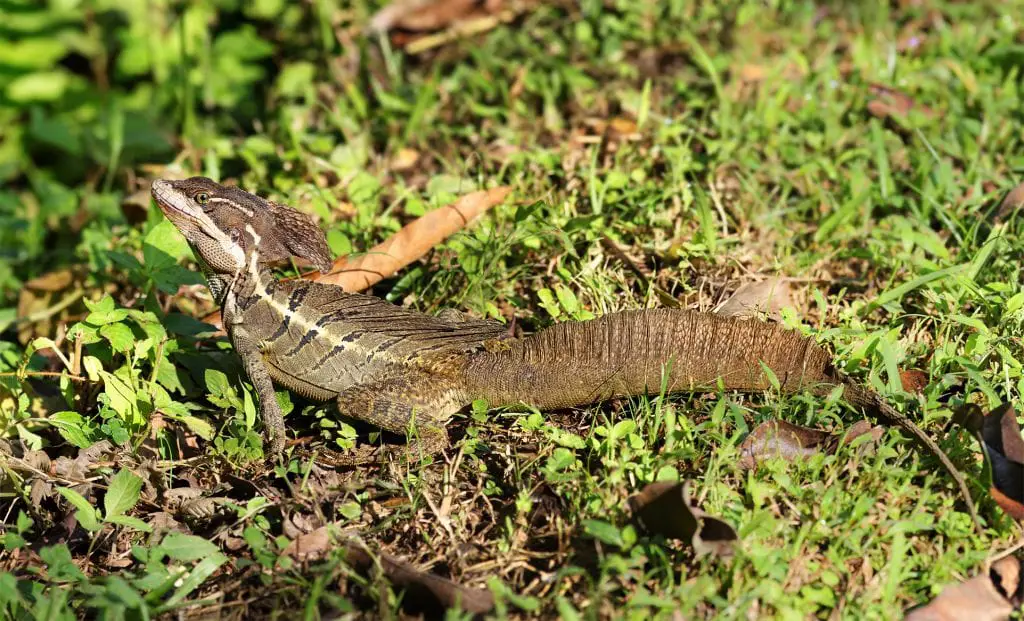
Basilisks are known to sleep high up in the branches of trees (up to 20meters) in their natural habitat, or respectively, on perches, when it comes to captive basilisks. These creatures are diurnal, meaning that they become active during the day when they get to rest, bask, and forage and they become inactive at night when they usually sleep.
Water
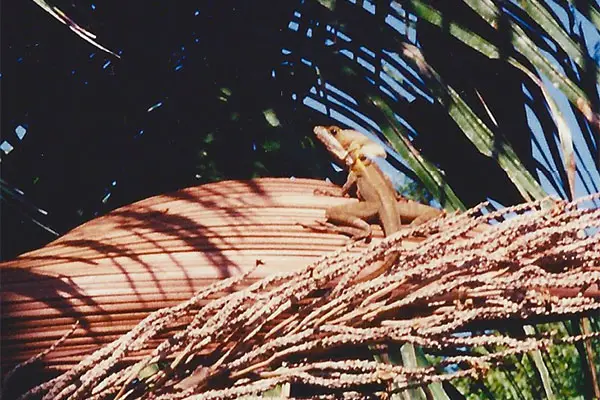
Providing a large water bowl is a must. Do mind, though, that these lizards will defecate in the water, so daily, regular cleaning of the water bowl is crucial.
Caregivers may never really get to see their basilisk drinking water straight from the water bowl; however, a water bowl remains an imperative part of the enclosure, even if only serving as a back-up.
Basilisks will almost certainly use the water bowl for bathing, so the size of the bowl should fit the size of the lizard. By soaking in the water, basilisks can cool down whenever desired. Also, soaking in water is very helpful when it comes to loosening shedding skin, thus, greatly assisting the shedding process in the running smoothly.
Make sure to place both the water bowl, as well as the food dish on the cool side of the enclosure, in order to prevent quick evaporation and drying off.
Development and Reproduction
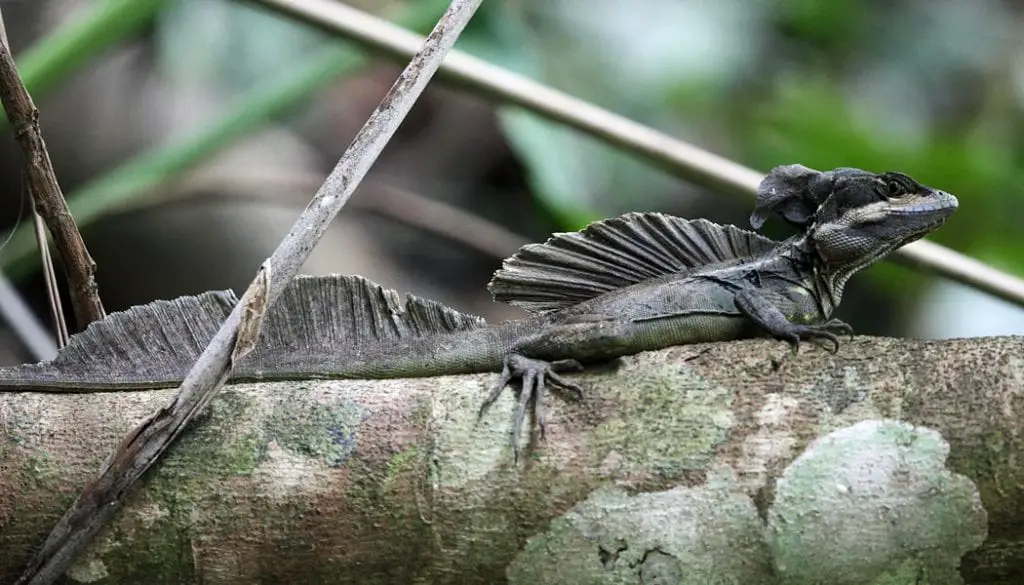
Striped/brown basilisks reach sexual maturity once they turn at least 10 months of age, although sometimes, this can happen as late as when they turn 15 months of age.
When still at a young age, sexually mature basilisks have not reached their maximum adult size yet. Male basilisks are known to develop more slowly than females, with most females reaching sexual maturity as they get about 135mm in length.
Experts believe that males usually reach full sexual maturity once they enter their second year of life, while females do so once they enter their 20th month of age.
Breeding occurs in March. Females are to lay clutches of eggs, typically containing as few as 2 and up to 18 eggs per clutch, over the course of ten months after successfully mating with a male. Larger females are reported to lay more eggs than smaller ones.
In the breeding season in the wild, larger males will frequently attack smaller males, thus, displaying size-related dominance and preventing the smaller ones from breeding.
How to Breed
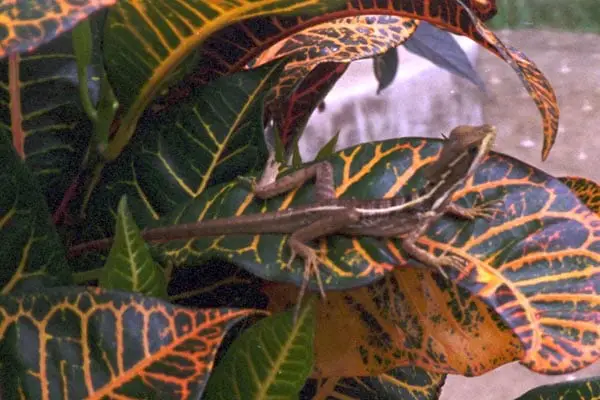
- For keepers who want to breed their common brown or striped basilisks, there is no need to do anything particular in order to encourage breeding. A sexually mature male and female should be introduced, and breeding may or may not occur.
- As long as the mating pair is in perfect health, and the conditions within the enclosure are carefully maintained as usually, breeding should occur all naturally.
- A gravid female must be granted access to a suitable nesting box for the purpose of laying the eggs. Make sure to have a nesting box all set and handy prior to Attempting to breed these lizards.
- The nesting box should be big enough for the female to be able to fully turn around once she gets inside. Provide a clean soil mix inside the nesting box, and keep it humid enough to hold its shape, yet never allow it to become overly wet. If too wet, eggs will be saturated, thus, failing to hatch.
- As soon as the keeper is to notices the female has laid eggs inside the nesting box, the eggs should be transferred into a suitable incubator. The temperature inside the incubator should be maintained stable at 84 degrees Fahrenheit.
- Sealed boxes can do a great job of incubating the eggs. Within about 60 days, the eggs will begin to hatch. Once the first babies are to emerge, they will quickly encourage the rest of the eggs to hatch successfully.
Handling
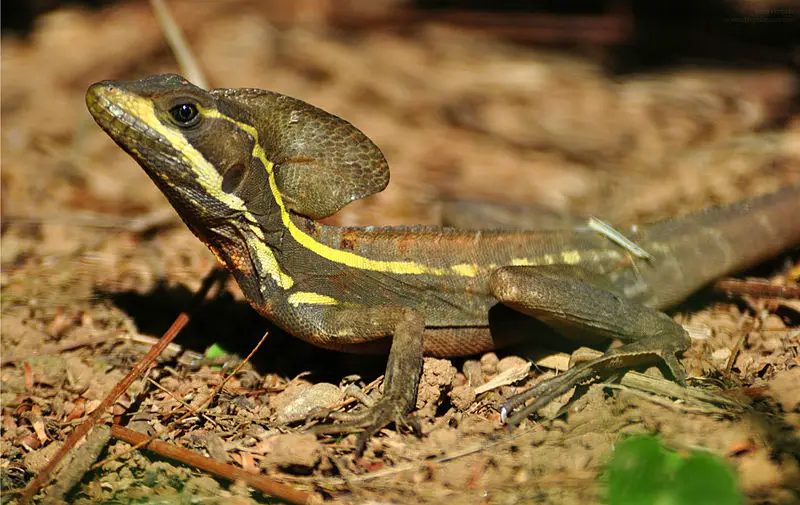
Unlike other lizards that can be gradually tamed down and handled regularly, this is not the case with brown common or striped basilisks. These wild-hearted creatures generally dislike being handled, even after spending years with their caregivers. This is not to say that these lizards do not make engaging pets; however, if you wish to acquire a reptile pet tolerable to handling, basilisks will not make the best option.
Handling should only take place when necessary, and not for the caregiver’s own joy. Also, mind that mature brown basilisks are equipped with quite powerful jaws and sharp teeth, as well as sharp claws, so wearing protective gloves and long-sleeved clothes when handling is strongly recommended.
How to Treat and Prevent Possible Health Issues
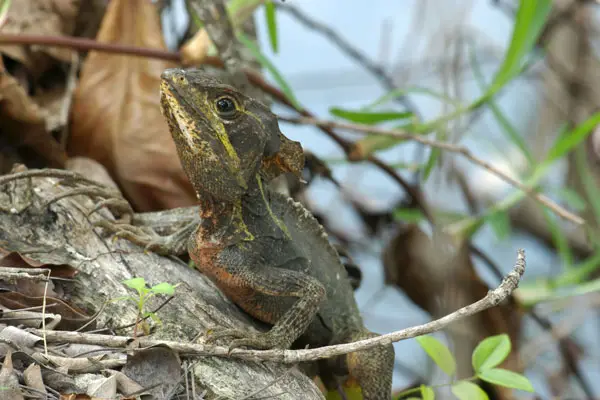
Nose rubbing and possible internal organs damage
Whenever captive basilisks are to feel exposed and/or stressed, they will commonly get to rub their noses along the enclosure’s walls. Doing so is linked with possible rostral trauma, and infections caused by open wounds are also highly likely to occur.
Although rarely than possible nose rubbing-related issues, basilisks may also suffer from internal organ damage if they are to run into the walls of the enclosure. In such instances, what happens to the lizard’s internal organs is quite similar to what happens to the human body during a car crash accident. Typically, the majority of contact if the lizard is to abruptly halt after smashing into the glass, occurs between the reptile’s face and the wall, causing the brain to be at higher risk of injury, and in severe cases, even possible death.
The unwanted health risks associated with the occurrence of any of the issues listed above are fully preventable, provided the enclosure is large enough to suit the size of the basilisk. Providing plenty of hiding spots will also lower the risk of such accidents.
Mind that lizards are far less likely to push against the enclosure’s wall if a strip of cardboard is placed strategically along the very bottom of any transparent walls, as the reptile will simply fail to see through the cardboard.
Essential supplements
Captive basilisks require additional calcium supplementation, which can be provided in the form of vitamins, calcium, or pure calcium.
Any of the calcium/vitamin supplements should be deprived of containing extra Vitamin D3 since these reptiles will produce enough vitamin D3 by optimizing UVB light provided by the caregivers through appropriate light bulbs and fixtures.
For keepers who are not sure whether the UVB light source within the enclosure will provide enough UVB light, the safest bet is to additionally supplement with some Vitamin D3.
Calcium powder should be dusted on food offerings every day, while calcium powder with D3 and balanced multivitamins should be provided with feeding only every other day.
Possible Dangers to Humans
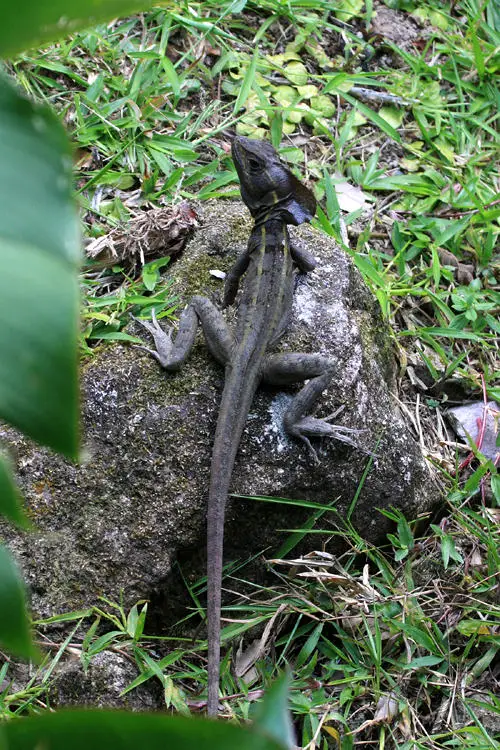
Salmonella
Like all reptiles, basilisks can infect humans with salmonella, although this is quite uncommon for high-quality, captive-bred basilisks. However, it is always imperative that keepers are to wash their hands thoroughly every time after getting in contact with their basilisk pet and/or any surfaces within the enclosure. Do never touch your mouth prior to washing your hands with hot, soapy water, as it is through the mouth of how salmonella bacteria can be transferred to humans.
Any children below the age of 6, as well as elderly people or those with weak immune system should avoid getting in contact with the basilisk pet, as these groups of people are more susceptible to Salmonella, and/or other bacteria that may be accidentally ingested after touching the lizard or any of the decorations and equipment within the enclosure.
Nasty bites
Mind that these lizards really dislike being handled, and in most cases, they will not hesitate to bite. The bite is painful, and bleeding is almost an inevitable consequence, especially if bitten by mature basilisks. If bitten, do not struggle, as this will only cause the lizard to further strengthen the grip. Stay calm and allow the basilisk to let you go.
Wash the bitten zone carefully with antibacterial soap and hot water. If swelling, redness, or other forms of severe irritation are to occur, consult immediately with a qualified physician, as not to end up with an infected wound.
Availability: How to Get a Brown Basilisk?
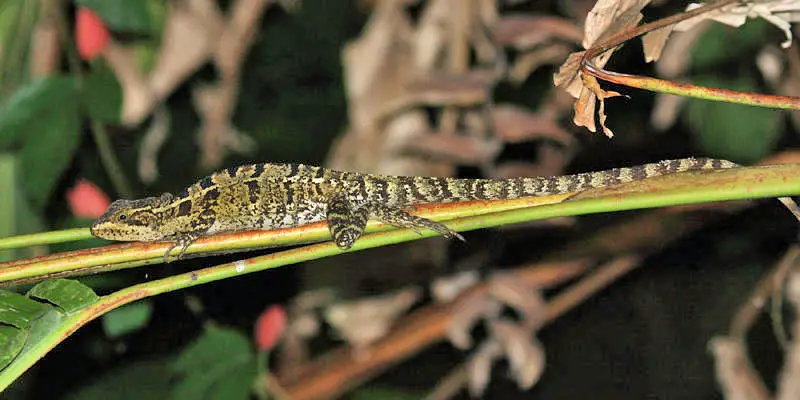
Brown common or striped basilisks are the most widely spread basilisks in the pet trade. These reptiles are fairly affordable; however, not every captive-bred basilisk has been taken proper care of.
If a basilisk appears malnourished, it is best to avoid purchasing the animal, as malnourishment is a solid sign that the breeders/retailers have been negligent towards the reptile’s health and well-being, and this could further indicate other hidden health issues.
As with all reptiles, wild-caught basilisks should be avoided. These can host a wide array of bacteria and parasites, so it is not worth the risk.
Fun Facts
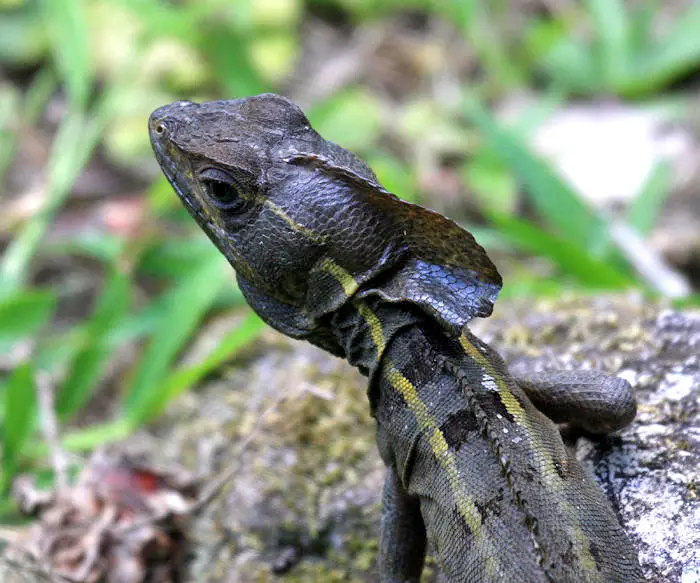
- The nickname Jesus lizard has been well-deserved by basilisks found in the wild, as when trying to escape from a possible predator, these amazing creatures appear as if running on the water’s surface. With captive basilisks, this particular behavior is quite uncommon, though, majorly due to the lack of suitable conditions for triggering it.
- If a basilisk is to attempt to make an escape from potential predators, it can remain underwater for up to 20 minutes. With captive basilisks, this behavior is most commonly limited to spending about 5 minutes underwater before they are to pop out their heads, curious to check out what’s going on above the water.
- One of the subspecies of a common basilisk, namely the B. b. barbouri, is found to inhabit a rather restricted range, limited to some parts of western Venezuela and eastern Columbia.
- Basilisks have the reputation of being rather jumpy. Although this behavior is typically well-controlled when it comes to captive brown common or spotted basilisks, these lizards definitely dislike frequent handling.
- Head bobbing is one of the specialties of basilisk lizards. Although it may seem as if the lizard is greeting you, this behavior is used as part of male courtship practices, in an attempt to demonstrate power and superiority. Also, this behavior is actually typical for many iguanid lizards.
- Even though captive basilisks usually live for over 9 years, this is not the case with wild basilisks. In the wild, these lizards have many natural predators, which is why they rarely live for more than 4 – 6 years on average (if lucky enough). Female basilisks tend to have shorter lives than males.
- The basilisks’ ears are very well-developed, serving quite similar functions as the ears of mammals, including balance, head movement, orientation, and, nonetheless, sound waves reception. With this in mind, captive brown common or striped basilisks should not be subjected to loud music, and especially bass, as doing so can easily stress out the animals.
How to Take Care of a Brown Basilisk
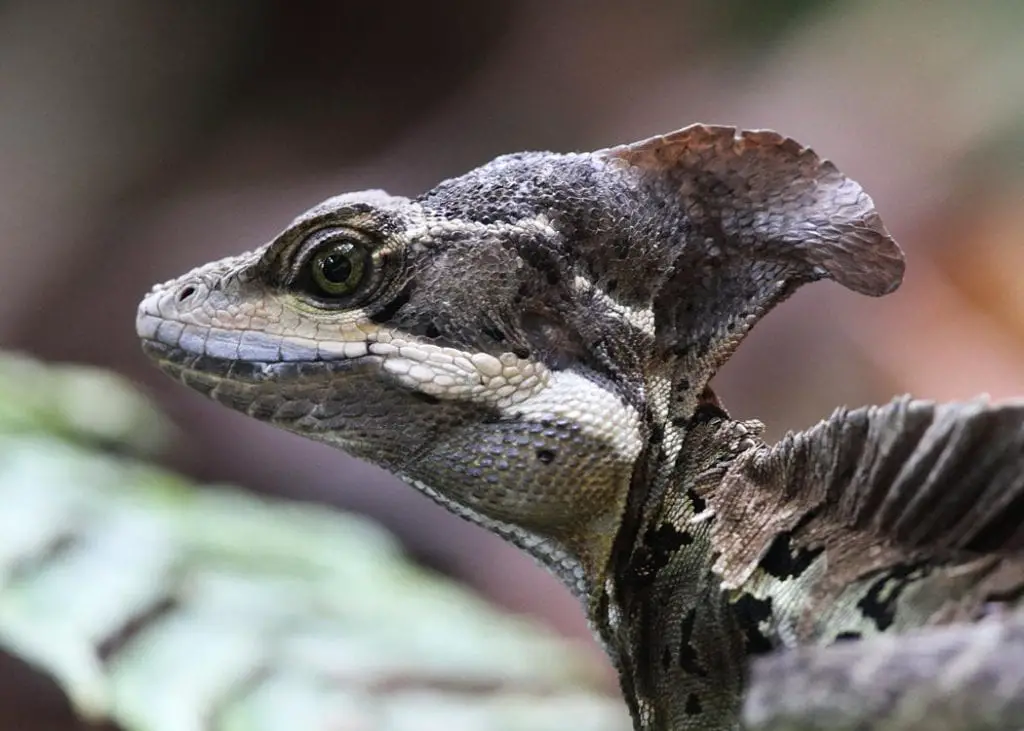
- Keep in mind that female brown basilisks are very food-aggressive. If housing a young male basilisk with several females, the male will highly likely end up malnourished because of getting into severe, unequal competition with the females. Apart from the male possibly developing more slowly, it can even be stressed into full submission by the females.
- It is best to house juvenile brown basilisks in separate enclosures. Doing so will allow males to grow healthy before being introduced to the females. Remember, cohabitating B.vittatus is fully possible, but it is not recommended to cohabitate these lizards before they reach sexual maturity, or the males will always prefer to hide, thus, remaining malnourished (and potentially unhealthy in return), instead of competing with the food-aggressive young females.
- Brown basilisks require a clean, highly hygienic environment in order to thrive. Spot cleaning the enclosure every day is a must. A full clean every month is crucial.
- For caregivers who intend to take care of a brown basilisk lizard in a bio-active enclosure, changing out the bedding at least 2 and up to 4 times per year is strongly recommended.
- Each time when cleaning the enclosure, keepers must remove all decorations, bedding, as well as the animal itself. Next, the entire enclosure should best be sprayed with a reptile-friendly disinfectant solution. Such type of solutions works fairly quickly, for as little as 30 seconds (make sure to read the instructions on the packaging). Once the recommended time has passed, the disinfectant simply needs to be wiped away with a clean paper towel.
- Do not hesitate to clean the enclosure, not once but twice if needed. It must be a spot, thoroughly clean.
- All decorations within the enclosure should be cleaned using the same method as described above, except for not merely wiping away the disinfectant reptile-friendly solution with a paper towel but by washing the decorations with water. Allow the decorations to dry off completely before hanging them back into the enclosure.
- It is best to clean the enclosure during the day so that the basilisk lizard pet will be allowed to go back to a warm, cozy environment, prior to the basking lamps being switched off for the night.
FAQ Section
How did Big Do Brown Basilisks get in Captivity?
Captive brown basilisks can reach pretty much the same size as wild basilisks. Males usually grow up to 24 inches in length, including the tail. Females grow somewhat smaller, though, usually up to 20 inches in total length.
How Long Do Brown Basilisk Lizards Live in Captivity?
Captive brown basilisks usually live for about 7 – 9 years on an average. Wild basilisks’ lifespan is shorter due to their natural predators. With proper care, captive brown basilisks can easily reach 12+ years of age.
What Do Brown Basilisk Eat?
Brown basilisks are primarily insectivores, as it is insects to make up the largest portion of their diet. However, these lizards also feed on various small fish, as well as aquatic insects. About 20% of basilisks’ diet consists of plant matter.
Do Brown Basilisks Bite?
Yes, brown basilisks can bite, but captive ones will rarely do so, as long as adequate feeding and care are provided by the keepers, and as long as excess handling is avoided. Note that if bitten by a brown basilisk, it is quite impossible to free yourself from the powerful grip of its jaws without causing severe harm to the reptile. In the case of basilisk bites, do not struggle but allow the animal to release its grip and thoroughly disinfect the painful wound.
Can Brown Basilisk Lizards Walk on Water?
Basilisk lizards are equipped with special, long toes with scales-like fringes of the skin allowing these reptiles to spread their rear feet out in the water. By doing so, it really seems as if the brown basilisk can walk on water, thanks to increasing the surface area of the foot when making quick contact with the water, further pumping their legs swiftly, while their feet are slapping hard against the water surface.
Do Brown Basilisks Make Good Pets?
For the right owner, brown common or striped basilisks can make great pets. Due to their quite cheap price tag, as well as the lack of bright coloration, many reptile enthusiasts underestimate the amazingness of brown basilisk pets. However, even though less eye-grabbing than other lizards, brown basilisks can make incredibly engaging, rewarding pets, yet this remains a matter of strictly personal choice and perspective.

